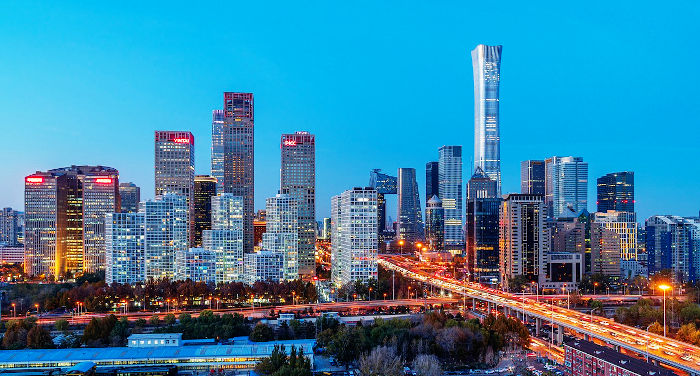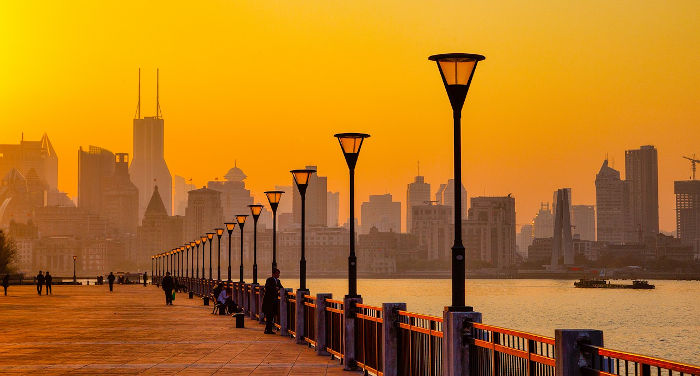
A project to revitalize the economy in the north of China
China’s impressive economic growth in the past 30 years has been amply guided by the development of two enormous urban conglomerates: the Blue River Delta (DFA) around Shanghai and Nanjing in central China, and the Pearl River Delta (DFP) around Canton and Shenzhen in the south.
These two urban realities, made up of one or two metropolises surrounded by a series of satellite cities, have combined to produce 25% of the country’s GDP. Moreover, in recent years, these two areas have become the world’s largest testing ground for the study of creating wealth through urbanization.
Both in the area around the Blue River and the area around the Pearl River, the borders and differences between urban realities are slight with the wealth being divided more evenly. The secret of success in these two areas is the consolidation of a series of small realities around a few main economic centers and the usage of the comparative advantage of each of these cities to forge a solid financial and manufacturing center.
In the meantime Beijing, as the only top-tier city in northern China, has sought to emulate the success obtained by the areas in the center and south of China.
In February 2014, Chinese President Xi Jinping announced the creation in the north of the country of the metropolitan region called “Jing-Jin-Ji” (“Jing” for Beijing, “Jin” for Tianjin and “Ji” for the province of Hebei, in Chinese “京津冀”, that surrounds the two cities).
In the arc of the next ten years, these three areas will be modernized and effectively connected with the objective of reducing the economic and development gap that divides the center, Beijing and Tianjin, with the areas on the outskirts, or the poorer areas within Hebei Province.
In addition this new mega-urban area has the purpose of reducing the profound differences in development that separate it from the country’s more prosperous economic belt: the Blue and Pearl River Deltas.
This new megalopolis, a metropolitan area that will extend over a surface area six times bigger than New York City and twenty-five times that of London, will help to bring new lifeblood to the economy of northern China and will become a laboratory for the study of new phenomenons of urbanization.
Even though Beijing, Tianjin, and Hebei Province are neighboring areas, on the whole, the area has always been divided both economically and politically. Each area is in turn subdivided into micro administrative and district regions that tend to protect their own interests and sources of power and autonomy. Jing-Jin-Ji is an attempt to reduce these internal divisions through effective technological and infrastructural integration.
The governmental program drafted in 2015 delineates the main objectives for the Jing-Jin-Ji area, namely: Beijing will remain the political, cultural, and innovative center; Tongzhou, a peripheral area 20 kilometers from the center of Beijing and at the border between Tianjin and Hebei, will host the main headquarters of the municipal government; Tianjin, thanks to its strategic position, will remain the heart of the manufactured goods and luxury technologies business; the Hebei region, lastly, will initially have the role of a national site for the implementation of manufacturing industries through the use of new production technologies.
Another objective of this development plan is to create new jobs and investments in Hebei, a province that surrounds the Beijing metropolitan area where 73 million people live.
A poverty belt around Beijing
Extended across an area of 100,000 square kilometers and with a population consisting of 130 million people, in 2014 Jing-Jin-Ji produced 10% of the Chinese GDP. Nevertheless, development throughout the region is deeply unbalanced. While Beijing is the cosmopolitan capital and Tianjin its outlet to the international market, Hebei remains a poor and underdeveloped region.
The concept of a “Poverty Belt” was introduced for the first time in 2005, when the Asian Development Bank (ABD) commissioned a group of researchers to study the level of development in the northern provinces of China. In 2012, President Xi Jinping visited Fuping, a very poor district located in Hebei, to see firsthand the living conditions of the local population.
When the video cameras of the CCTV, the Chinese national broadcasting station, captured muddy streets, collapsing houses and the general poverty in which the citizens were forced to live, it set off a national debate centered on how to resolve just such a situation.
Besides being poor, the Hebei region is also extremely polluted. Heavy industry, first and foremost in the sectors of steel and coal production has contributed to 50% of the province’s GDP in 2014. Besides leading Hebei’s economic growth, the heavy industry generates PM 2.5 particulates, which are extremely dangerous to man in the long term.
According to a study by Greenpeace, in 2015, three out of five cities with the highest PM 2.5 rates in the air were in Hebei.
At the same time, the central government has been trying for years to limit the number of residents in the capital, going from 15.34 million in 2005 to 21.7 million in 2015. In addition, following the slowdown of the Chinese economy and in particular the production of steel and coal, Premier Li Keqiang placed a 6.5% growth objective of the Chinese GDP for the year 2016, the lowest since 1991.
Under pressure to reduce pollution and adapt to a new economy that is no longer solely driven by industrial production but above all by internal consumption, the Chinese government can transform the Hebei region and at the same time reduce congestion in the capital. The new region will connect research and development centers in Beijing with the port of Tianjin and the inland region of Hebei, making cooperation among the three areas ever simpler.
In 2017 the headquarters of the central government will transfer from the center of Beijing to Tongzhou
The central government has sought to create a commercial and administrative system to redistribute wealth and population in an effective way. In July 2015, Beijing announced a plan that foresees the transfer of the main government headquarters from the city center to the peripheral area of Tongzhou.
The plan is for Tongzhou, which up until 2004 was a stretch of fields vested in agricultural production, to become the administrative center of Beijing, directly connecting the capital with Tianjin and Hebei. A new city will be built, including a stadium that will hold up to 30 thousand people, and a series of services from schools to hospitals. The project will be completed in 2017, and Beijing predicts that nearly 15% of current capital residents will move to Tongzhou, bringing their money and investments with them so as to accelerate the process of economic growth in this area.
In Hugezhuang, near Tongzhou, numerous rundown homes were demolished to make space for a theater, stadium, hospital, schools, and a railway station. The government has also compensated local inhabitants with new apartments. The population embraced the revitalization of the area with joy, happy with the fact that their one-time poor little city will go from a rural area to the administrative center of the country.
Hukou Reform
Defined as a permanent resident permit, the hukou is a basic document issued at the birth of every Chinese citizen that allows an individual to have use of services such as education and health care in their city of origin, even if the subject in question has moved away from their city of birth a long time before.
On one hand, the hukou system has reinforced regional differences, on the other it is feared that if this impediment for internal movement is removed, citizens will pour into the richest cities, thereby worsening the quality of their services.
Up until now, hukou reform is not part of the Jing-Jin-Ji area development project and many experts have questioned if this might not be one of the main obstacles for the success of the development plan.
According to Li Chang’an, professor with the UIBE of Beijing, “coordinating regional industries and infrastructure was relatively easy, but workers will be reluctant to move into areas where they cannot make use of the same services offered to local citizens. Only when Beijing promotes hukou reform will they finally realize the regional development plan”.
Results and future challenges of the Jing-Jin-Ji project
At only two years since its proposal, the Jing-Jin-Ji plan has already shown important developments and changes: 22 biochemical industries have been moved from Beijing to Cangzhou, in Hebei; 865 commercial projects are under construction in Tianjin and another 6.431 projects in Hebei, with total investments equal to 124 billion USD.
The section between the south station of Beijing and the airport in Tianjin now takes less than an hour, Beijing and Tianjin have been connected by a high-speed train for some time which has reduced the trip length from three hours to 30 minutes, and toll costs for moving around the interior of the three areas have been eliminated. Beijing is also building a second main airport near Daxing, a peripheral area located to the southeast of the capital; By 2025, about 72 million passengers a year will transit through this new airport.
Thanks to the reduction of coal as an energy source, it was calculated that in 2017 the PM 2.5 concentration in the areas where Jing-Jin-Ji will emerge will fall to 70 micrograms per cubic meter, 25% less compared to 2015. To better connect the region, Beijing has already planned the construction of high-speed rail lines. By 2020 8 new rail lines will be constructed inside the Jing-Jin-Ji area, to which they will add another 16 by 2050. The government will also build about 940 kilometers of highway that will connect 11 cities in Hebei and two districts in Tianjin.
Jing-Jin-Ji already produces 10% of the Chinese GDP and 6% of the population lives in this area. These figures have allowed the new megalopolis to surpass the Pearl River Delta in terms of productivity and will soon pass the Blue River cluster; nevertheless, the lack of important economic-structural advantages in the two areas in the south of China will not cause many problems for the Municipality of Beijing in the future.
On a theoretical level, an urban agglomeration is composed of a number of small to mid-range sized cities that surround and are guided by a principal city. However, a super-urban agglomerate like the one being built in the north of the country foresees that there might be more economic centers able to administrate the economic-infrastructure development of the area under consideration.
In the course of decades of development and integration, many second-tier cities have arisen in the areas of the DFP and DFA. These include Hangzhou and Suzhou near Shanghai, Foshan, and Dongguan around Guangzhou and Shenzhen. The GDP per capita of these satellite cities is now equal to that of the main cities. In 2015, while the GDP per capita of Canton was 134 thousand RMB, Foshan was already 108 thousand RMB. While the GDP per capita of Shanghai was 103 thousand RMB in 2015, Hangzhou in the same year registered 112 thousand RMB per capita, surpassing that of Shanghai.
In the Jing-Jin-Ji area, Beijing is by far the most important and dominant city in all aspects. Other cities in the area, excluding Tianjin, are mostly unknown and insignificant on an economic level. The more Beijing develops, the more the divide between the center and the periphery increases.
In 2015 the GDP per capita of Beijing was at 106 thousand RMB, while nearby Shijiazhuang, the capital of Hebei, came in at 50 thousand RMB per capita. This means that before being able to reach the hoped-for results, Beijing will need to dedicate time and money into bridging the disparity between the cities and the internal areas of the Jing-Jin-Ji area. The majority of Hebei’s population is still involved in agricultural production and for some time the government is fighting against the lack of potable water, air pollution, and corruption on the part of local functionaries.
Beijing will have to coordinate with Hebei and the city of Tianjin in order to favor a better circulation of technical knowledge and experts, and at the same time best take advantage of comparative advantages that the three areas enjoy, such as a solid banking system, an international port, and low-cost workforce, so that the productive poles can be reallocated in a more efficient way.
In short, the success of the Jing-Jin-Ji project largely depends on systematic and meticulous planning and execution on the part of numerous government initiatives. Only when every area involved in the project’s strong points are fully put to use will we see the birth of the largest urban center in the world. The integration of the three areas will require an alignment of the level of services offered, primarily in education and health care, but it’s unlikely that current residents of Beijing will accept cuts to their benefits following a hypothetical increase in urban population.



